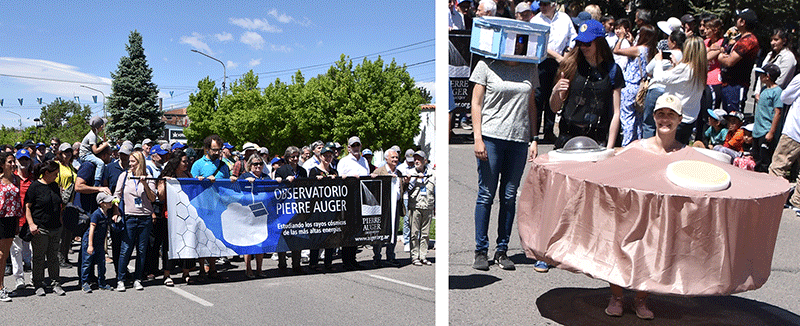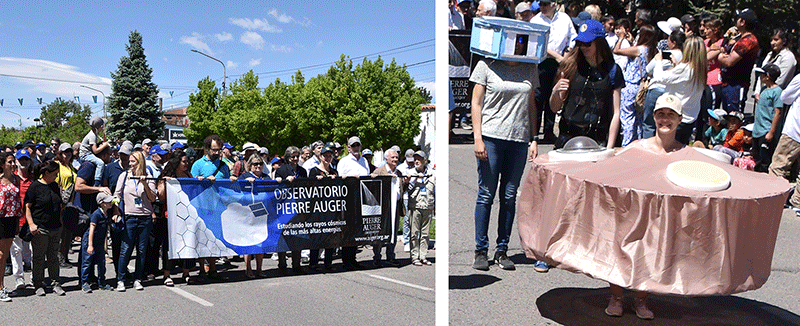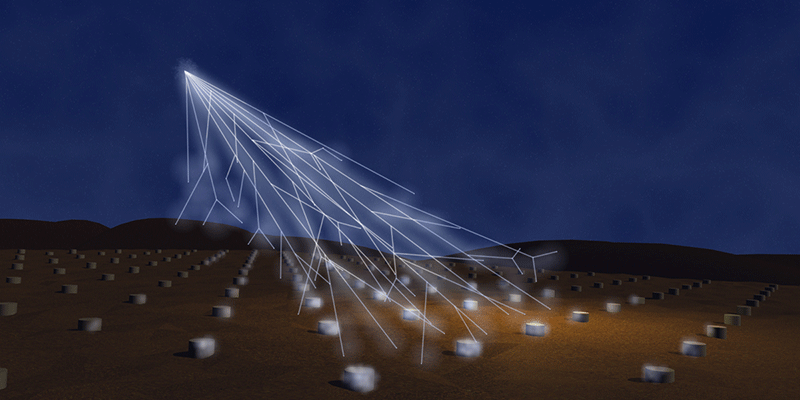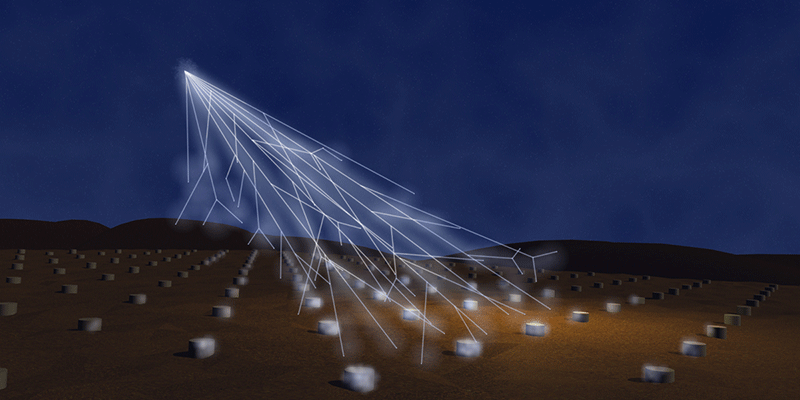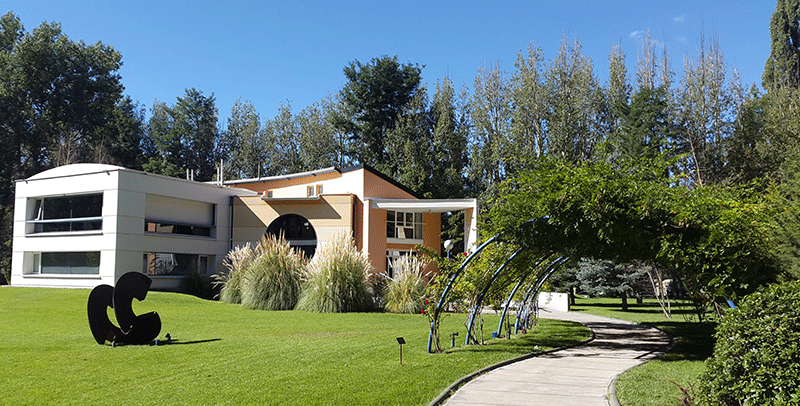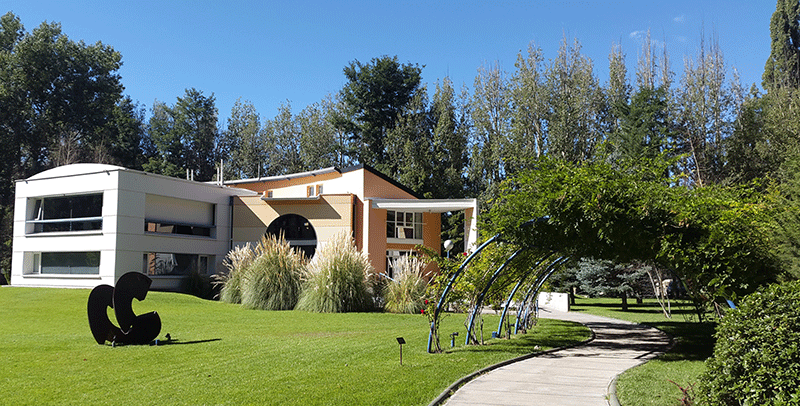20 Years of Cosmic Rays at Pierre Auger
Masquerading as a Cherenkov detector might invite quizzical looks at a typical party. But in the good company of cosmic-ray physicists in a parade, it raises cheers.
Each November, more than a hundred scientists from around the world come to the small town of Malargüe, Argentina, home of the Pierre Auger cosmic-ray observatory. The goal is to discuss results and future plans, but the scientists also join in the Malargüe Day parade on November 16th, which celebrates the town’s official founding in 1950.
“This is a very touching event because the scientists in the collaboration participate. And when they walk by, the town claps,” says Ingo Allekotte of the Bariloche Atomic Center in Argentina and a project manager for Pierre Auger.
The event this year was all the more special because it marked the 20th anniversary of Auger’s ground breaking. The largest cosmic-ray observatory in the world, it was also the first major experiment to be based in Argentina.
The brainchild of physicists Jim Cronin and Alan Watson, Auger is a unique detector for cosmic rays—an energetic blend of mostly protons and heavier nuclei that hail from sources within and beyond our galaxy. The rain of cosmic rays on our atmosphere span in energy from eV to beyond eV—about ten million times more energetic than the particles produced at CERN. By studying the composition, intensity, and sky location of the cosmic-ray flux at different energies, researchers gather clues about the astrophysical sources that accelerated the particles and the interactions they had en route to Earth.
Auger is tailored to look for the high-energy portion of the cosmic-ray spectrum— particles of eV and above. These particles are rare—only one eV particle per week strikes a square kilometer of the Earth’s upper atmosphere, which means they would be almost impossible to detect with a single detector in space. Auger and other so-called ground-based experiments cast a wider net by looking for the “shower” of secondary, lower-energy particles produced when a cosmic-ray particle hits an atom or molecule in the atmosphere. Having the widest net in the world, Auger is one of the few observatories that can detect ultrahigh-energy cosmic rays (UHECRs)—particles with energies above eV, whose source is an ongoing mystery.
To gather the full profile of the shower, the observatory combines two detection schemes: 1660 water tanks (Cherenkov detectors) that signal the passage of fast-moving charged particles and four elevated fluorescence detectors that capture radiation from atmospheric nitrogen. The footprint of the detectors is greater than 30 times the size of Paris, and the need for vast, flat terrain with clear skies was one of the reasons that Malargüe was chosen as a site.
Thomas Gaisser, a cosmic-ray physicist at the University of Delaware, recalls being amazed at the size of the observatory when he visited. “Driving back to the airport, for the first 30 miles, you keep seeing these detectors.”
Physicists’ understanding of UHECRs has evolved since Auger’s ground breaking. Before the collaboration began taking data, measurements painted a conflicting picture of UHECRs. The expectation had been that the UHECR flux, being mostly protons, would fall off rapidly at a certain energy because of the protons’ interaction with the cosmic microwave background. But while the High Resolution Fly’s Eye detector in the US saw this so-called GZK cutoff, the AGASA experiment in Japan observed a more gradual roll-off, potentially suggesting a novel source of UHECRs, like the decay of unknown heavy particles.
Auger and other experiments later showed that the cutoff was indeed sharp. In 2017, Auger also determined that the sources of UHECRs are almost certainly extragalactic. But exactly what those violent sources are and why they produce the observed spectrum of particles is still a mystery. Researchers have been surprised, for example, that the composition of the UHECR flux tends towards heavier nuclei at higher energies, a trend that means the simple picture explaining the cutoff isn’t the case, says Gaisser.
Understanding the sources of UHECRs is one of the drivers for an ongoing upgrade of the observatory, called AugerPrime. Among several improvements, the collaboration is installing underground muon detectors, radio-wave antennas and new scintillators on top of the water tanks, and faster electronics. When combined, these enhancements will help researchers identify the primary particle that spawned a shower event, improving on the rough statistical picture they have now. One goal is to isolate proton events: Protons are deflected less by magnetic fields than heavier particles, providing a clearer idea of the direction from which they arrived—and therefore a better sense of what sources are responsible for UHECR.
Beyond its discoveries, Auger is an important fixture in Argentina, which is still in many ways considered a developing country. The observatory was always intended to be an international collaboration, and Allekotte says it boosts connections between Argentinian researchers and the rest of the world. Auger has also helped the country attract other scientific projects, such as an antenna for deep-space viewing that was installed in Malargüe by the European Space Agency.
From the outset, Auger’s researchers have made efforts to be part of their community. The observatory hosts a biennial science fair for high school students across the country, and this year’s themes included the moon landing and the periodic table. Years ago, local children named each of the detectors. “These names are proudly shown on the detectors, and we usually refer to our detectors by name instead of by number,” says Charles Timmermans, a physicist at the National Institute for Subatomic Physics (Nikhef) and Radboud University in the Netherlands, who leads Auger’s outreach efforts. Auger also offers internships to students, and some have resulted in permanent employment.
“Being part of the community means contributing to the community,” says Timmermans.
Auger has also contributed to the tourism industry in Malargüe, a town of about 27,000. In 2008, the collaboration helped found the Malargüe planetarium, a popular destination. And in addition to the scientists who come to Auger and fill the town’s hotels, the observatory itself attracts about 9000 visitors per year. “In a small town like Malargüe,” says Allekotte, “[this] makes a difference.”
–Jessica Thomas
Jessica Thomas is the Editor of Physics.



